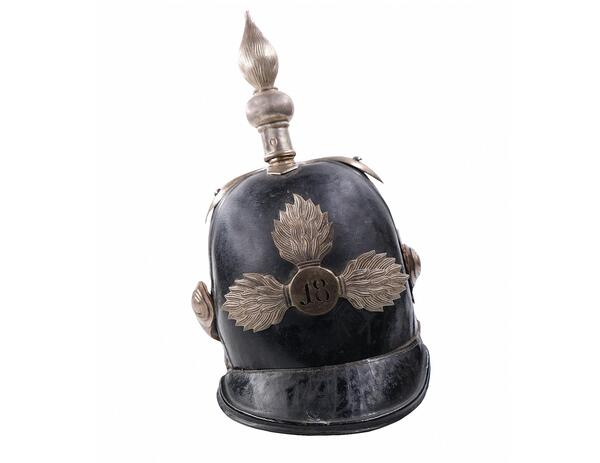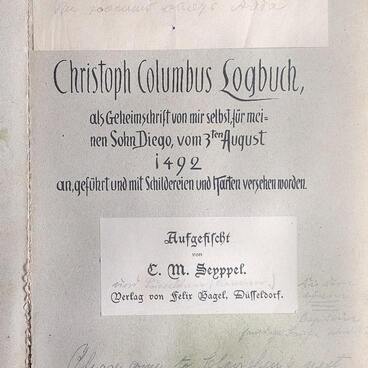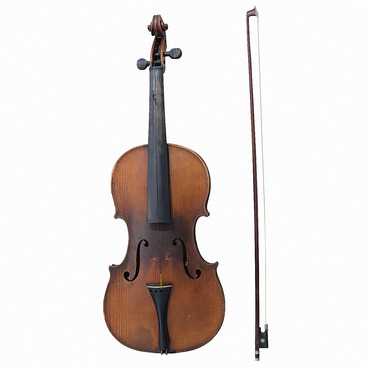The regular army in the Russian Empire was created by Peter I, leading to the increasing importance of uniforms. Over the centuries, military clothes have changed more than once, influenced by the changing fashion, as well as the taste of each emperor.
The helmet from the museum’s collection was created in the middle of the 19th century. It is made of black patent leather, and the inside is covered with silk. Visors are located in front and behind, and a special belt is provided for fixing the helmet on the chin.
Similar headdresses appeared in 1844–1845. They replaced shakos (flat-topped headdresses) in separate units. In 1844, their form was personally designed by Emperor Nicholas I together with Major General Lev Kiel.
In 1855, when Alexander II ascended the throne, helmets were replaced by the shakos again. However, they did not fall out of use at once: it was simply impossible to quickly re-equip the entire army, so such helmets left the military gradually.
Since the early 19th century, the universal system of special unit emblems of the major arms began to take shape. In the frontal part of the helmet, there is a special metal plate in the form of a grenade with three rising flames. The number “18” is engraved in the middle of it.
In 1827, the grenade insignia was received by maneuver units that stood on the Russian border lines. In 1845, the emblem passed to the state garrison battalions — military teams assigned to serve in cities and fortresses in peacetime. The garrison helped residents execute court sentences, as well as caught escaped convicts and army deserters, helped collect taxes, maintained order at fairs and festivals, and performed other similar tasks. There were also units of garrison troops in the Kargopol region.
The helmet from the museum’s collection is made of expensive materials — patent leather, silver-plated metal, and silk. It could have belonged to an officer during the period from 1845 to the 1850s, but researchers have not determined the exact military unit of its owner.
The helmet from the museum’s collection was created in the middle of the 19th century. It is made of black patent leather, and the inside is covered with silk. Visors are located in front and behind, and a special belt is provided for fixing the helmet on the chin.
Similar headdresses appeared in 1844–1845. They replaced shakos (flat-topped headdresses) in separate units. In 1844, their form was personally designed by Emperor Nicholas I together with Major General Lev Kiel.
In 1855, when Alexander II ascended the throne, helmets were replaced by the shakos again. However, they did not fall out of use at once: it was simply impossible to quickly re-equip the entire army, so such helmets left the military gradually.
Since the early 19th century, the universal system of special unit emblems of the major arms began to take shape. In the frontal part of the helmet, there is a special metal plate in the form of a grenade with three rising flames. The number “18” is engraved in the middle of it.
The grenade with three rising flames is a long-established emblem. It was originally developed in 1812 for sapper units of engineering troops. Soon the engineering troops received a different insignia, while grenadiers began to wear the grenade with three flames. Grenadiers were in both infantry and cavalry armies. In addition to guns, they were armed with grenades for assaulting fortresses. This military branch recruited tall, strong men and was considered elite. Some historical sources indicate that the grenade with three flames was the sign of the Grenadiers up to 1827.
In 1827, the grenade insignia was received by maneuver units that stood on the Russian border lines. In 1845, the emblem passed to the state garrison battalions — military teams assigned to serve in cities and fortresses in peacetime. The garrison helped residents execute court sentences, as well as caught escaped convicts and army deserters, helped collect taxes, maintained order at fairs and festivals, and performed other similar tasks. There were also units of garrison troops in the Kargopol region.
The helmet from the museum’s collection is made of expensive materials — patent leather, silver-plated metal, and silk. It could have belonged to an officer during the period from 1845 to the 1850s, but researchers have not determined the exact military unit of its owner.



